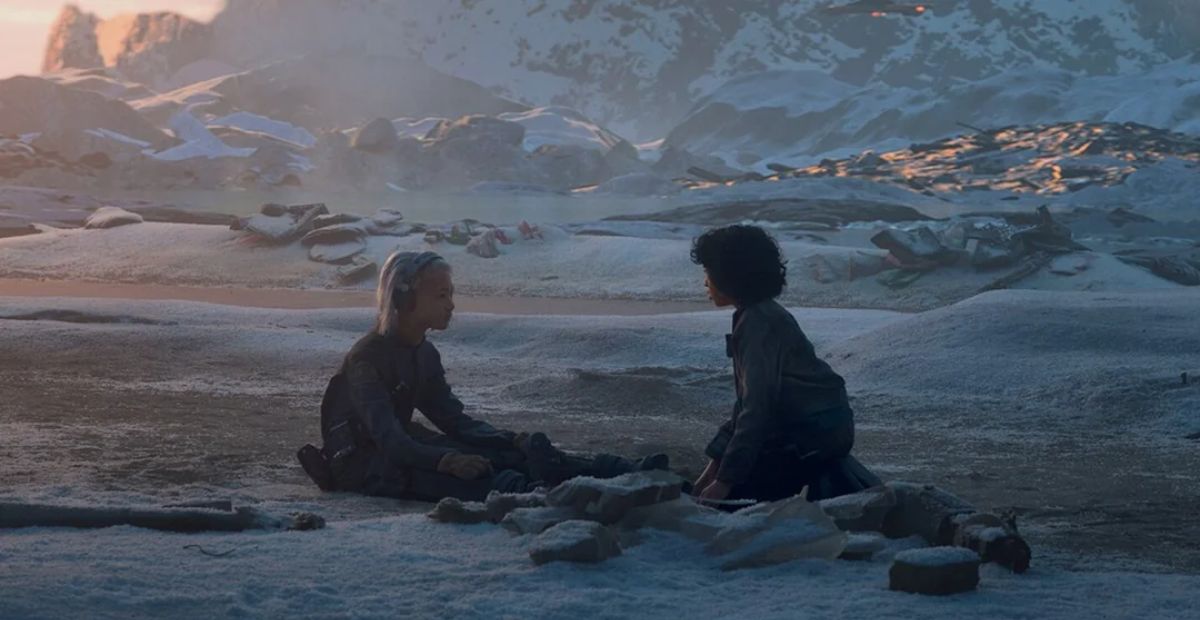Accolades have gone out to The Skeleton Crew for its contributions to the Star Wars franchise. Episode 6: Zero Friends Again showcases some of the reasons why, as it reveals the struggles, triumphs, and everyday life of a disabled character. KB’s story in this episode and the series is a game changer for Star Wars because of how it realistically engages with disability representation.
KB’s Story in The Skeleton Crew
KB is one of the four children starring in The Skeleton Crew. Like her friends, she is from the planet At Attin and accidentally becomes “lost in space.” Unlike her friends, though, KB previously experienced an accident that “caused her to need the aid of cybernetic prosthetics.”
In the series, KB’s disability is not immediately explored. Instead, we get a hint in Episode 3 when one of KB’s parents indicates that she has “urgent medical needs.” We have noticed KB’s visor already, but still don’t know much about it. We may have wondered, does KB have extra-sensory powers from it? Perhaps she was like Lobot from The Empire Strikes Back.
In Episode 6, we find out more about KB and her disability because her story is front and center. The four friends split up once Fern and KB disagree over climbing a cliff to return to their ship. KB and Wim follow a ground path until her augs, or cybernetic implants, fail from corrosion. We reach “a critical moment” as KB talks to Wim “through the process of forging the replacement part she needs” to keep her alive and moving.
KB and Wim work together to repair the Augs, with KB revealing how she is both vulnerable and resourceful. That her character reflects these traits helps lead us into why this episode and KB’s story are crucial to Star Wars.
Why Is KB’s Story a Game Changer for Star Wars?
Fans specify several reasons why KB’s story is a positive contribution to Star Wars, such as how it’s alright to have limits to what people feel they can do and how Wim subtly helps KB. The writing in Episode 6 helps deliver key messages without forcing them on the audience. That subtlety and realism are part of the reason why the episode and show shake-up Star Wars.
This article explores how Star Wars has “historically fallen short” with representing disabilities. The franchise has included characters like Saw Gerrera who “relies on a breathing apparatus” and explored blindness through Kanan Jarrus and Chirrut Imwe. Yet, these portrayals tend to be either “supporting roles” or “disconnected from the lived experiences of disabled individuals.”
The show is thus a game changer because it not only departs from previous trends but does it in a way that is “authentic” and not “superficial.” The inclusion of a disabled character is not a “token” effort but enmeshed in the story. KB is a main character and her story gets authentically woven into the series.
Another article extends this line of reasoning by indicating how KB’s blindness is not used as a “path to superhuman abilities,” as in past portrayals like Lobot or Jarrus. Instead, KB experiences “her unique form of blindness as another fact of life”, a part of her reality, and as “a tool to navigate the world around her.”
The realistic intentions of the show provide a new departure point in a way that is different from past shows and current ones like Andor, which has its own harsh reality under the Empire’s reign. The reality in Skeleton Crew is meant to connect with more everyday experiences on Earth.
For individuals with disabilities, the episode and show revive memories of their “own story” and what they “experienced as a kid.” Moreover, KB provides an avenue for “kids watching” this series to have “a reference for what it is like to endure what KB lives with on a daily basis.” It’s a relevant story for today and would have helped in the past too.
KB’s Story and The Skeleton Crew
KB’s story makes a major contribution to making The Skeleton Crew a frontrunner show for leading Star Wars in new directions. This thoughtful move toward disability representation augurs well for future shows and movies in the franchise. We get reminded of the daily challenges and otherworldly adventures of individuals with disabilities.

